Published
- 14 min read
Best Railway Alternatives for Solo Developers and Startups
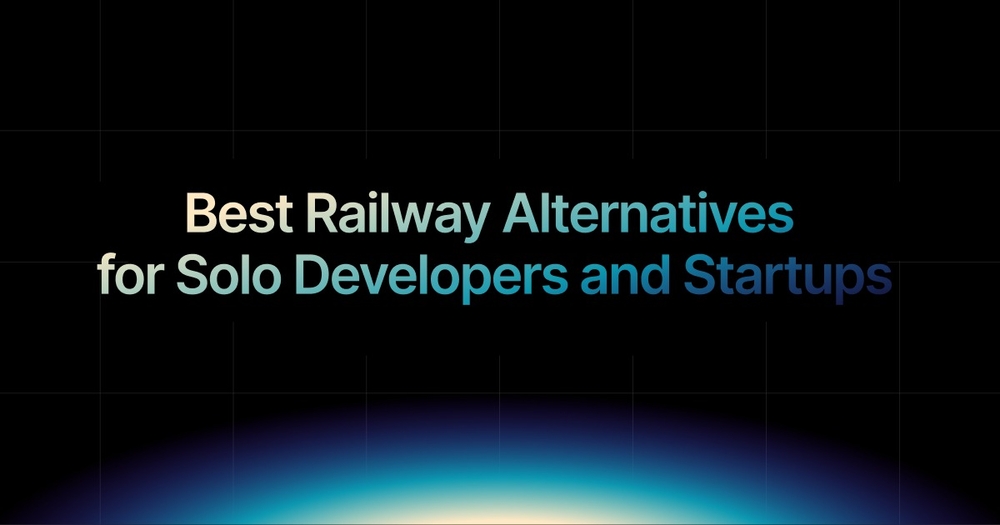
Introduction:
When searching for a reliable Railway alternative, solo developers and startups often find themselves juggling cost, scalability, and simplicity all at once. Railway is popular for its ease of use, but as apps grow or requirements get more complex, its limitations start to show.
For solo developers building side projects or small startups trying to stay lean, choosing the right PaaS platform can save hours of headaches, hundreds of dollars, and countless deployment errors.
If you’re exploring Railway alternatives to better suit your growing needs, you’re not alone. Many developers are seeking alternatives that offer more flexibility, better pricing, and smoother scaling as their apps and teams evolve.
In this guide, we’ll look at the top Railway alternatives for solo developers and startups, compare them on cost, scaling, and simplicity.
Whether you’re a solo developer launching your first app or a startup scaling to multiple users, this guide will help you choose a Railway alternative that’s simple, reliable, and tailored for your needs.
Why Solo Developers and Startups Need the Right PaaS Solution?
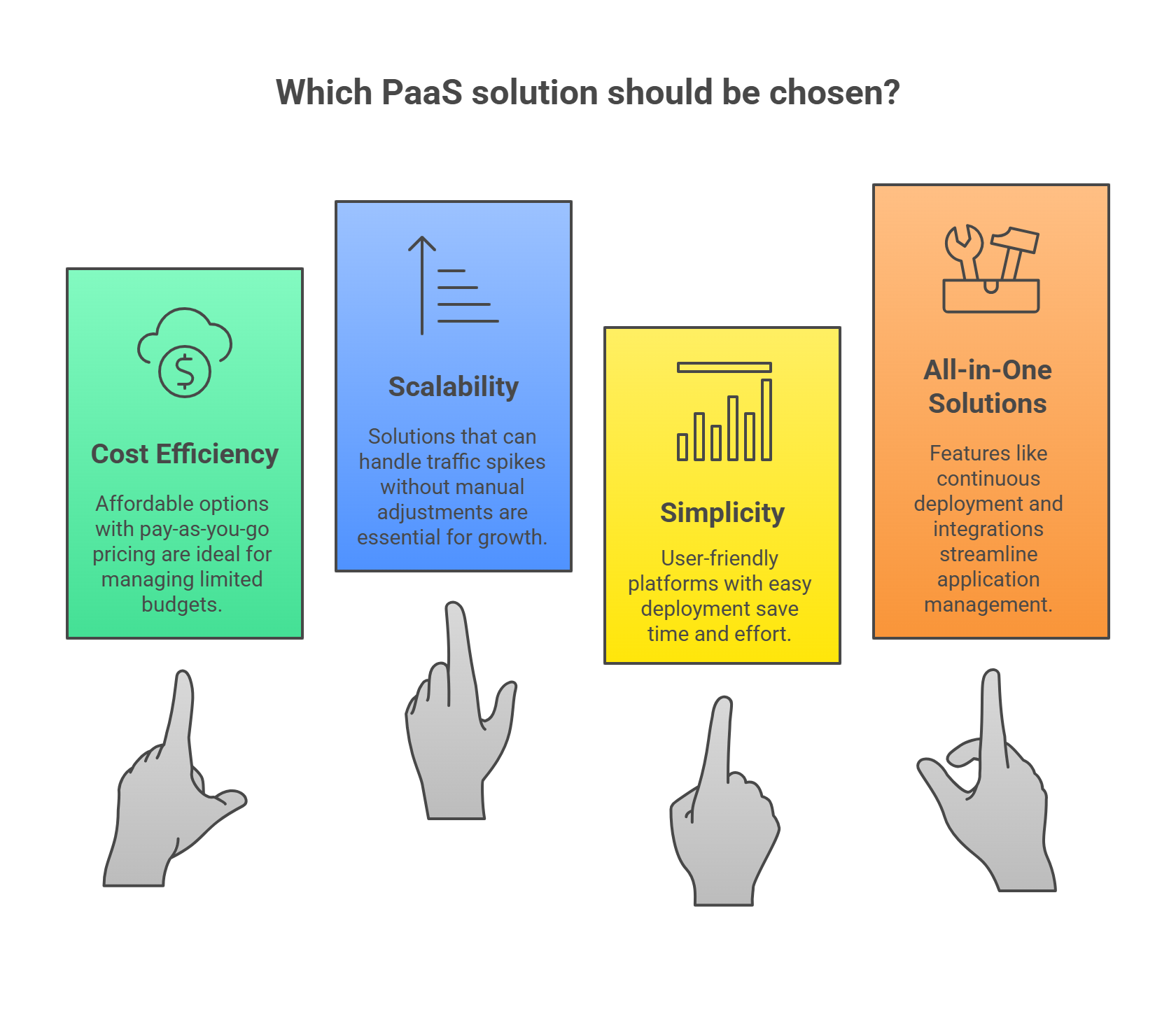 For solo developers and startups, selecting the right Platform-as-a-Service (PaaS) is not just about picking any cloud solution. It’s about choosing one that fits the unique challenges they face.
For solo developers and startups, selecting the right Platform-as-a-Service (PaaS) is not just about picking any cloud solution. It’s about choosing one that fits the unique challenges they face.
With tight budgets, limited resources, and the need to scale quickly, finding a PaaS that is cost-effective, easy to use, and scalable is essential for long-term success.
This is why understanding the specific needs of solo developers and startups is the first step in making an informed decision.
Cost Efficiency
One of the biggest hurdles solo developers and startups face is managing limited budgets. Traditional cloud infrastructure can quickly become costly as your project grows, especially when you’re using a PaaS that doesn’t have a flexible pricing model.
This is why affordable PaaS options are a must. Platforms that offer pay-as-you-go pricing are ideal for projects that need to get off the ground without incurring steep upfront costs.
Scalability
Another important consideration is scalability. As a solo developer or startup, you need a PaaS that can grow with your project.
If you suddenly get a spike in traffic, your PaaS solution should be able to handle that without you having to manually adjust configurations or deal with slow, painful migrations.
It’s not just about scaling your app; it’s about scaling it efficiently.
Simplicity and Developer-Friendliness
The best PaaS for solo developers and startups should be easy to use. You want to spend your time coding, not worrying about configuring servers or dealing with complex infrastructure.
A developer-friendly platform with clear documentation, easy deployment, and minimal setup time will save you hours (or even days) of work.
The platform’s intuitive dashboard and easy-to-navigate interface should simplify the deployment process, even for developers who are new to deployment.
All-in-One Solutions
Finally, many solo developers and startups require an all-in-one solution that allows them to quickly deploy, manage, and scale their applications.
Features like continuous deployment, integrations with GitHub and GitLab, and automatic load balancing are becoming standard in modern PaaS offerings.
These features are essential for making sure that solo developers can deploy their applications smoothly, without wasting time on configurations or downtime.
With these core features in mind, it’s clear why the right PaaS is so important for solo developers and startups.
A platform that offers simplicity, scalability, and cost-effectiveness can be the difference between hitting your goals and facing ongoing infrastructure headaches.
Top Railway Alternatives for Solo Developers and Startups
We’ve curated a list of the top 7 Railway alternatives, focusing on platforms that offer cost-effectiveness, easy scalability, and developer-friendly features.
Whether you’re a solo developer trying to get a personal project off the ground, or a startup looking to scale, these options are designed to meet your needs.
Let’s dive into the details of each platform, highlighting their features, ideal use cases, and unique selling points.
Kuberns: The All-in-One Solution for Solo Developers & Startups
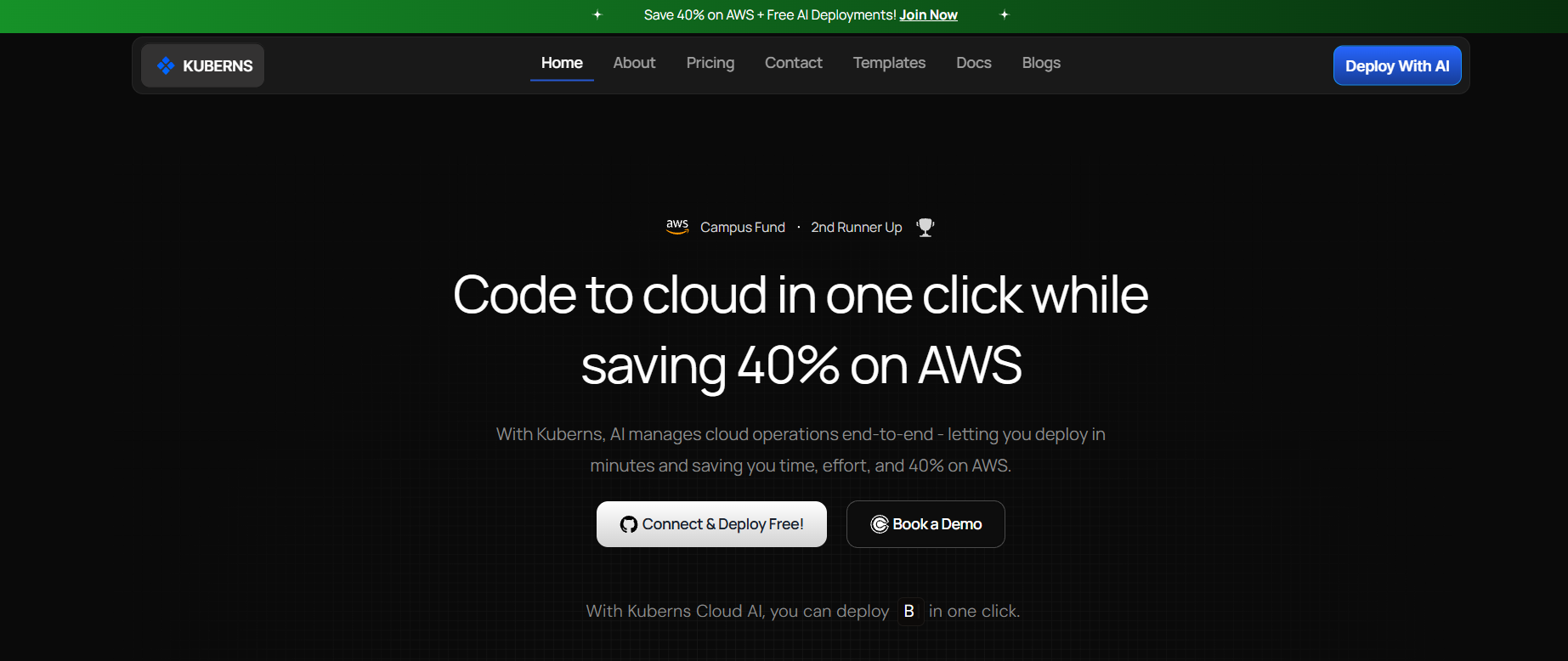 Kuberns is designed specifically for developers and teams who want hassle-free deployment.
Kuberns is designed specifically for developers and teams who want hassle-free deployment.
Unlike many PaaS platforms that require juggling multiple tools, Kuberns provides everything in a single platform:
Key Features & Benefits:
- One-Click Deployment Platform: This
- Cost Optimisation: Solo developers and startups can save up to 40% on AWS costs thanks to kuberns’ Unused resource Utilisation. Startups can get AWS infrastructure without committing to long-term plans.
- Automated Deployment: CI/CD pipelines, infrastructure, SSL, and custom domains are all built in, so you spend less time configuring infrastructure.
- Monitoring & Logs: Access real-time logs and metrics to quickly identify and fix issues without third-party tools.
- Multiple Environments: Easily manage development, staging, and production environments from a single interface.
- User-Friendly UI: A clean and interactive dashboard helps even non-DevOps users deploy and monitor apps efficiently.
- Responsive Support: Small teams get the attention they need with fast, knowledgeable support.
Kuberns is ideal for developers building side projects, MVPs, or growing apps.
Render: Reliable Full-Stack PaaS with Simple Deployment
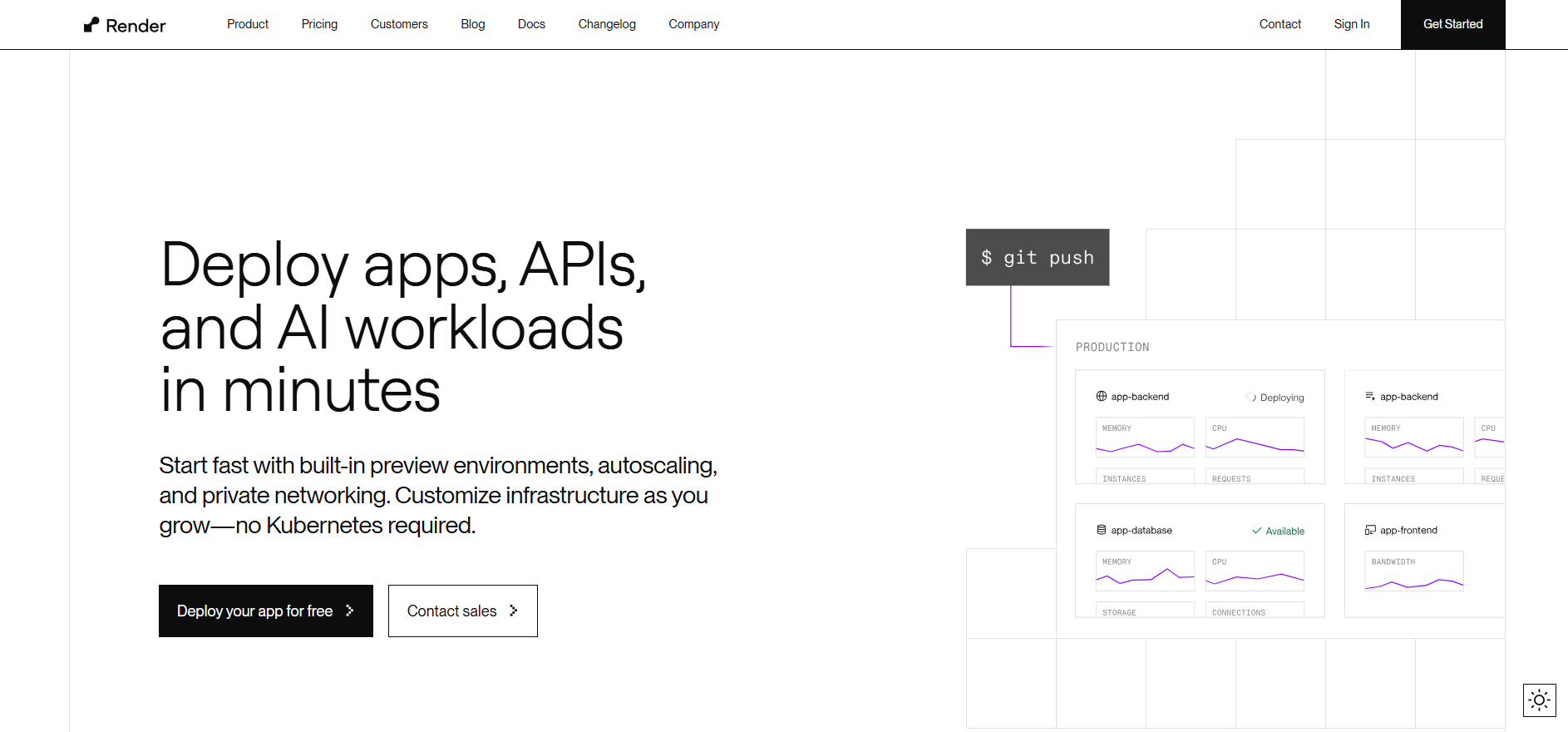 Render is another popular alternative to railways for startups and solo developers. Its strength lies in quick setup and straightforward deployment for both static and backend apps.
Render is another popular alternative to railways for startups and solo developers. Its strength lies in quick setup and straightforward deployment for both static and backend apps.
Why It Works:
- Git-Integrated CI/CD: Deploy apps automatically whenever you push changes to GitHub or GitLab.
- Managed Databases: Built-in support for PostgreSQL and Redis reduces backend setup complexity.
- Custom Domains & SSL: Automatic HTTPS provisioning makes sites production-ready fast.
- Scaling Options: Render supports vertical scaling, but costs can grow quickly as traffic increases.
While Render is great for small apps, startups may find it less flexible if they need multi-environment management or detailed monitoring, which Kuberns handles more comprehensively.
Learn more in our Render alternatives guide
Fly.io: Distributed Global Apps Made Simple
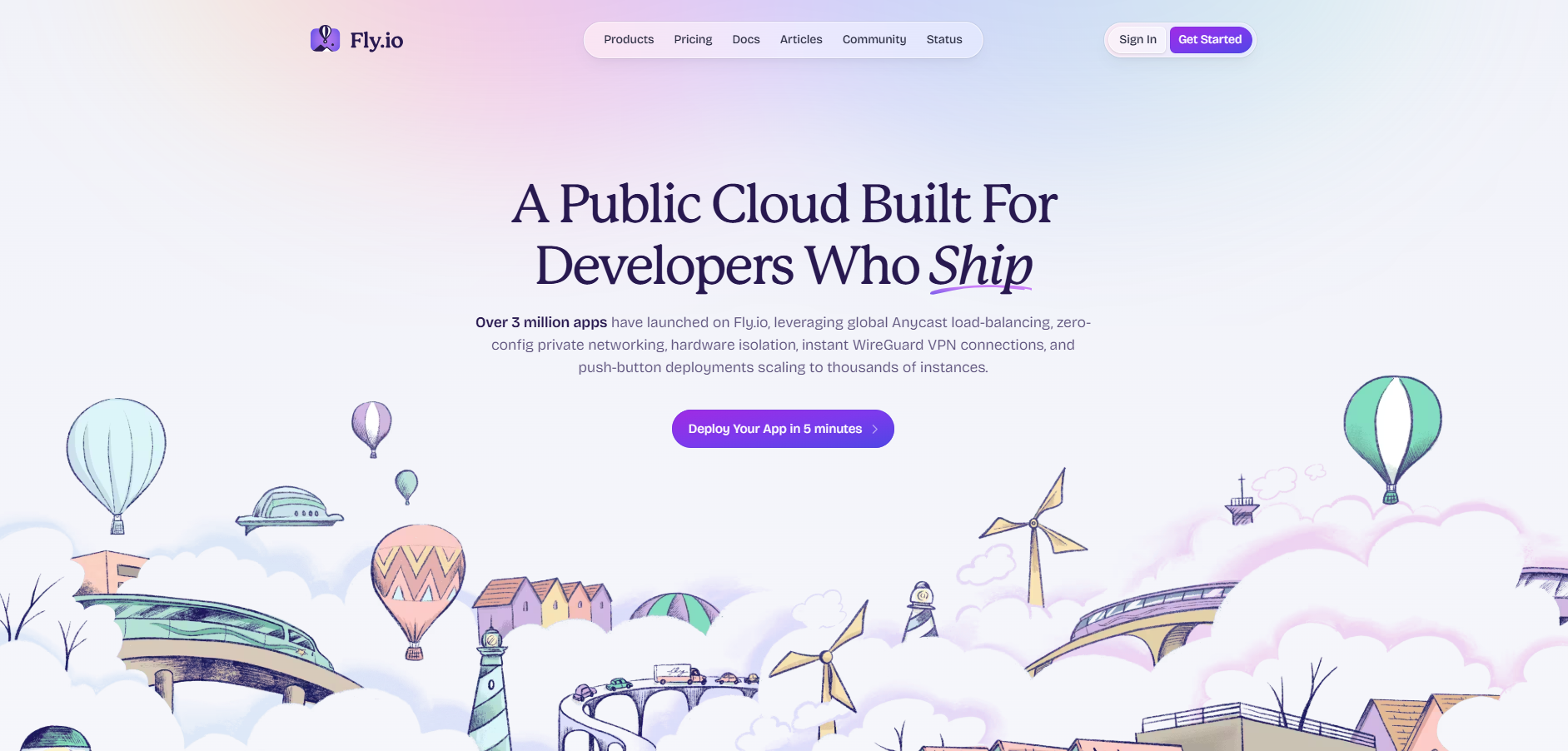 Fly.io specialises in running apps close to users globally, making it an attractive Railway alternative for performance-focused developers.
Fly.io specialises in running apps close to users globally, making it an attractive Railway alternative for performance-focused developers.
Key Features:
- Edge Deployment: Apps can run near end-users for low-latency experiences.
- Auto-Scaling: Automatically scales applications based on demand.
- Container-Based Architecture: Allows developers familiar with Docker to deploy efficiently.
- Free Tier for Small Projects: Good for prototyping or MVPs.
Why it suits: If your app requires fast global response times, Fly.io can be a solid choice.
However, it may require more DevOps knowledge than Kuberns to set up monitoring and multi-environment workflows.
Netlify: Front-End Focused, Developer-Friendly PaaS
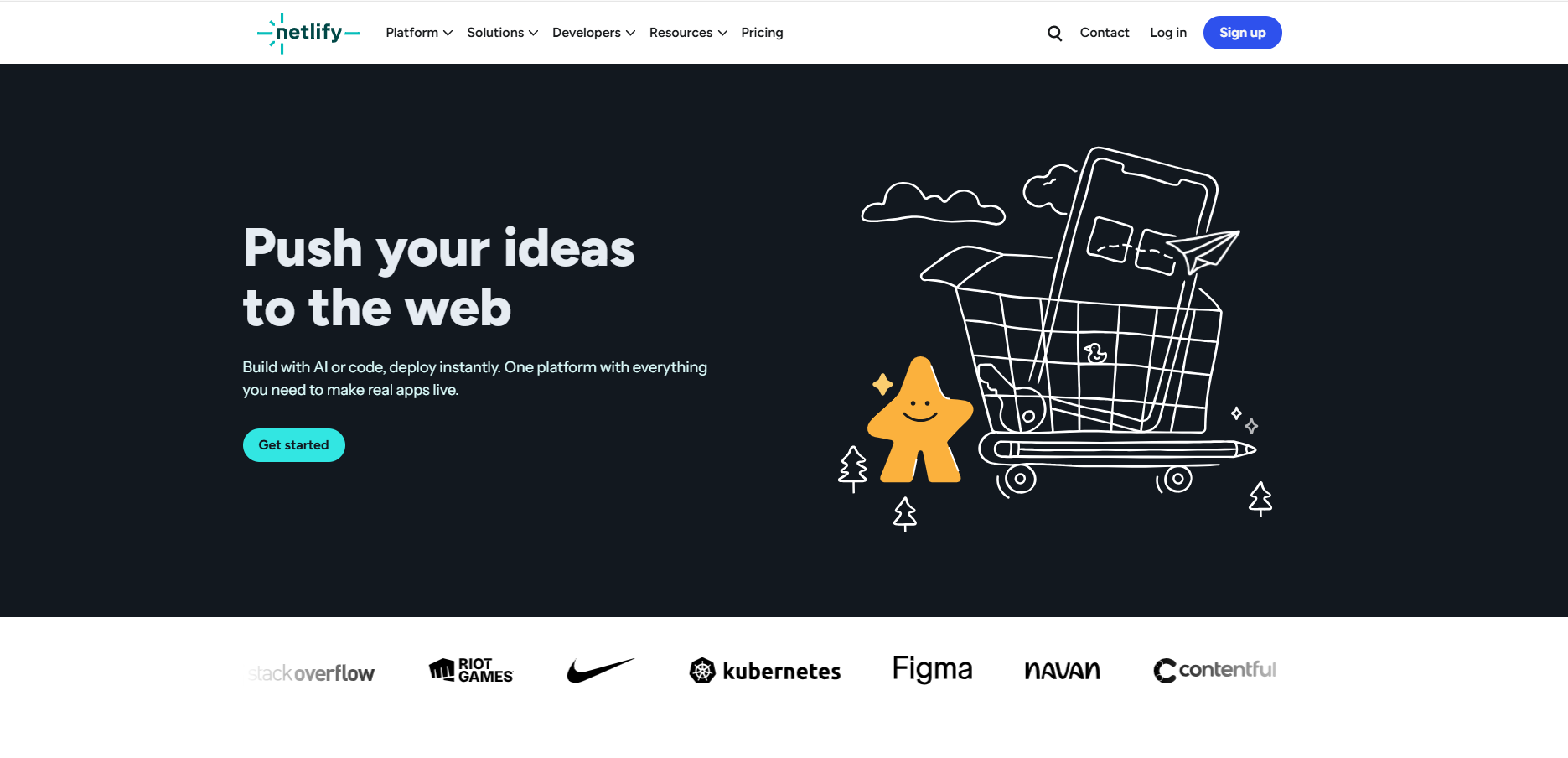 Netlify is a go-to platform for front-end developers, especially for static sites, Jamstack apps, and small full-stack projects.
Netlify is a go-to platform for front-end developers, especially for static sites, Jamstack apps, and small full-stack projects.
What Makes Netlify a Strong Railway Alternative:
- Automatic CI/CD: Push code to GitHub, and your site updates instantly.
- Serverless Functions: Run backend logic without managing a server.
- Form Handling & Functions: Perfect for MVPs with minimal backend needs.
- Simple Pricing for Small Apps: Transparent cost structure.
Limitations for Startups/Solo Developers: While it excels at front-end projects, developers with backend-heavy apps or multiple environments may need additional tools.
Check our Netlify alternatives guide for more insights
DigitalOcean App Platform: Flexible Cloud Deployment
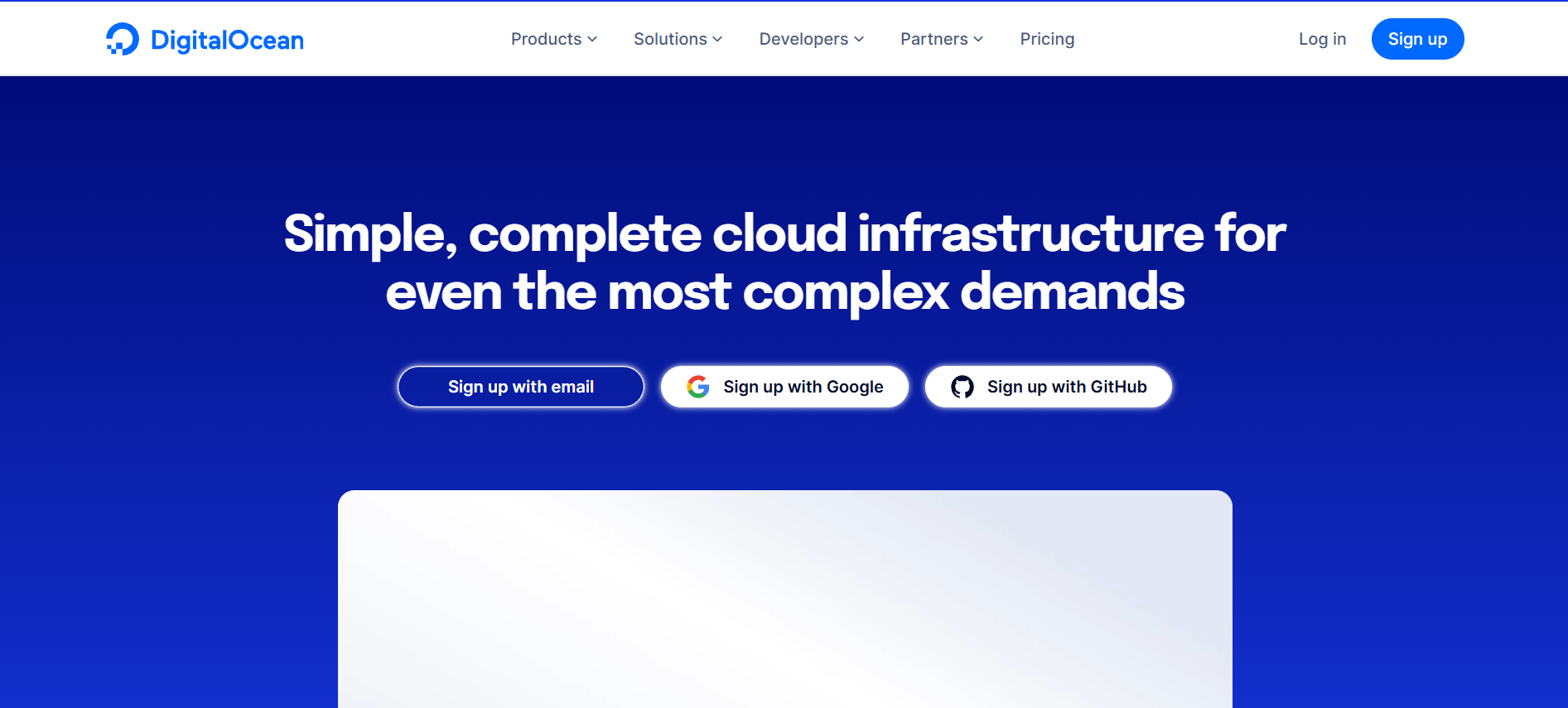 DigitalOcean App Platform offers a cloud-native PaaS experience, making it a viable Railway alternative for startups that want some control over infrastructure without full DevOps overhead.
DigitalOcean App Platform offers a cloud-native PaaS experience, making it a viable Railway alternative for startups that want some control over infrastructure without full DevOps overhead.
Features:
- Git-Based Deployments: Automatic build and deployment from Git repos.
- Scalable Infrastructure: Vertical and horizontal scaling options for growing apps.
- Managed Databases: Reduce backend complexity.
- Custom Domains & HTTPS: Simplified production setup.
Why It Works: It’s ideal for startups ready to manage some cloud infrastructure, but solo developers may find the learning curve steeper compared to Kuberns’ simplified UI and automation.
Need a flexible cloud platform? Explore DigitalOcean Alternative
Northflank: CI/CD and Container Management
 Northflank is designed for developers comfortable with Docker and containerised apps.
Northflank is designed for developers comfortable with Docker and containerised apps.
Key Features:
- Built-In CI/CD Pipelines: Automate builds and deployments efficiently.
- Monitoring & Logs: Keep track of app performance and health.
- Environment Management: Supports multiple stages for dev, staging, and production.
Why It Works for Solo Developers/Startups: If you want full control over containers without building an entire DevOps workflow, Northflank is a good choice.
Kuberns offers a simpler alternative with similar features but a more beginner-friendly interface.
Comparing the Best Railway Alternatives for Cost, Scaling, and Simplicity
When choosing a Platform-as-a-Service (PaaS), especially for solo developers and startups, it’s crucial to compare platforms based on three main factors: cost, scalability, and simplicity. These elements are the foundation of any successful deployment and will directly impact your development workflow.
To help you make an informed decision, we’ve created a comparison table that highlights the core features of each of the top Railway alternatives.
| Platform | Cost Efficiency | Scaling Capabilities | Ease of Use & Automation | Best For |
|---|---|---|---|---|
| Kuberns | Up to 40% AWS savings; pay only for what you use | Auto-scaling, multiple environments | One-Click Deployment, All-in-one UI, CI/CD, monitoring, logs, SSL | Solo developers, startups, Enterprises |
| Render | Transparent for small apps; can grow costly | Vertical scaling supported | Git-based deployments, simple UI | Solo developers, hobby projects |
| Fly.io | Free tier available; usage-based pricing | Global edge scaling, auto-scale | Docker-based deployment, CLI support | Performance-focused apps |
| Netlify | Free & predictable for small front-end apps | Limited backend scaling | CI/CD integrated, serverless functions | Front-end and Jamstack apps |
| DigitalOcean App Platform | Pay-as-you-go; scalable | Vertical & horizontal scaling | Git-based deployment, some DevOps required | Startups needing cloud flexibility |
| Northflank | Usage-based pricing | Container-based scaling | CI/CD pipelines, environment management | Developers familiar with Docker |
What Makes a Good PaaS for Solo Developers and Startups?
When searching for a Railway alternative, it’s easy to get overwhelmed by the number of platforms available. Not all PaaS solutions are created equal, and the right choice can make a huge difference for solo developers and startups. To simplify the decision, here are the key factors that define a good PaaS:
1. Ease of Deployment and Automation
A top PaaS should let you deploy your app in minutes, not hours. Look for platforms that:
- Offer CI/CD pipelines to automate builds and deployments
- Include pre-configured environments for development, staging, and production
- Provide logs and monitoring out of the box.
2. Cost-Effectiveness
Startups and solo developers need predictable costs. Consider:
- Usage-based pricing that scales with your app’s growth
- Free tiers or trial credits for experimenting without high upfront costs
- Platforms that optimise cloud resources to reduce wasted spend
Kuberns stands out by offering up to 40% savings on AWS infrastructure, making it one of the most cost-effective Railway alternatives for small teams.
3. Scalability
Your app should grow with your users. Look for platforms that support:
- Automatic scaling based on traffic or resource needs
- Multi-region deployment for better performance (if applicable)
- Flexible environment management to test new features safely
4. Multi-Environment Management
Testing new features before going live is crucial. A good PaaS should allow you to:
- Create separate development, staging, and production environments
- Switch deployments easily between environments
- Maintain consistent settings and configurations across all environments
5. Support and Reliability
Even the best platforms sometimes run into issues. Consider:
- Responsive customer support or community forums
- Platform reliability and uptime guarantees
- Clear documentation and tutorials
Summary: A good Railway alternative balances ease of use, cost, scalability, multi-environment support, and reliable support. For solo developers and startups, choosing a platform that combines these features into a single, intuitive platform like Kuberns can save time, reduce errors, and accelerate growth.
Choose the Right Railway Alternative for Your Project
Now that we’ve explored the top Railway alternatives and discussed what makes a good Platform-as-a-Service (PaaS) for solo developers and startups, it’s time to help you decide which platform is the best fit for your specific project.
Here are some key questions to ask yourself when choosing the right PaaS:
- What Type of Application Are You Building?
- What Is Your Budget?
- How Much Control Do You Need Over Infrastructure?
- How Important Is Speed and Global Performance?
- How Much Developer Support Do You Need?
Why Kuberns is the Best Choice for Your Startup or Solo Developer Project?
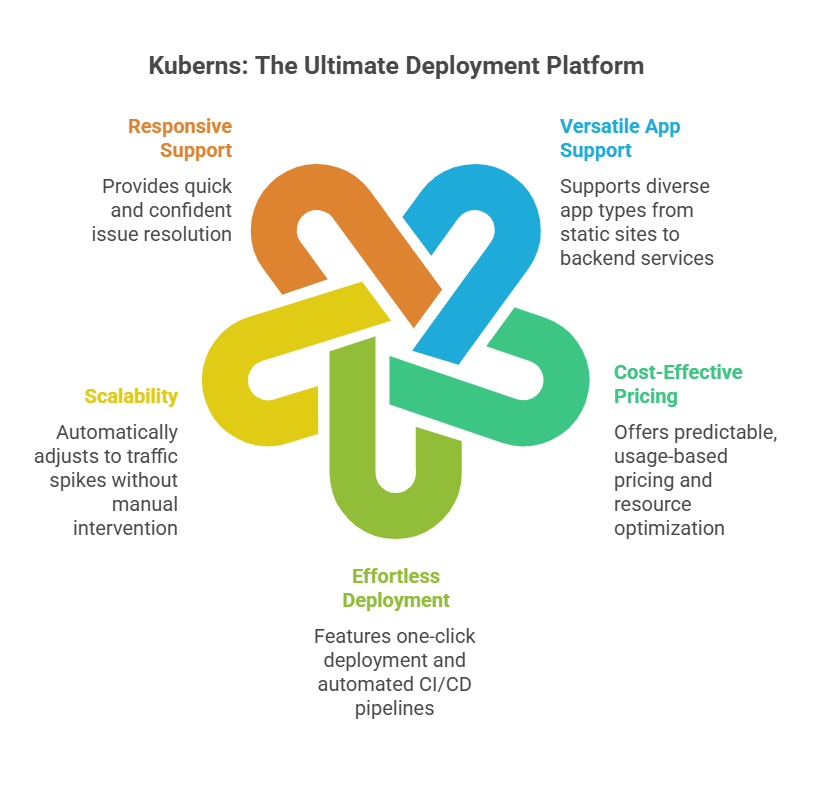 Unlike other PaaS solutions that specialise only in front-end apps or require multiple tools for full-stack deployment, Kuberns supports a wide range of app types, from static sites to backend-intensive services, allowing developers to manage their entire workflow in one place.
Unlike other PaaS solutions that specialise only in front-end apps or require multiple tools for full-stack deployment, Kuberns supports a wide range of app types, from static sites to backend-intensive services, allowing developers to manage their entire workflow in one place.
- It’s predictable, usage-based pricing ensures startups can experiment with MVPs or side projects without worrying about unexpected costs, while optimised resource management can save up to 40% on AWS infrastructure.
- Deployment is effortless thanks to one-click deployment, built-in CI/CD pipelines, Docker support, multi-environment management, and automated monitoring and logging, letting developers focus on building features rather than configuring servers.
- Additionally, Kuberns makes scaling effortless, automatically adjusting to traffic spikes without requiring a dedicated DevOps team, and its responsive support and intuitive interface help small teams resolve issues quickly and confidently.
By combining these advantages, Kuberns provides a stress-free, efficient, and reliable platform for startups and solo developers who want to ship apps faster, scale smoothly, and keep costs under control, making it the smartest choice among Railway alternatives.
Want a reliable and scalable platform for your project? Start with Kuberns today and experience hassle-free app deployment and scaling.
Conclusion: Making the Right Decision for Your Startup or Solo Developer Project
Now that you understand the advantages of each platform, it’s time to take action. Start by evaluating your project’s requirements:
- Are you working on a static site or frontend-focused app? Platforms like Netlify or Render may be your best fit.
- Do you need more control and scalability? Kuberns offers one-click deployment and global scaling capabilities.
Once you’ve identified your requirements, you can make a more informed decision.
If you’re looking for a reliable, scalable, cost-effective solution with developer-friendly features, Kuberns is ready to help you take your project to the next level.
Don’t wait to get started.
Sign up for kuberns and begin your journey toward seamless deployment and scalable infrastructure!

Frequently Asked Questions
1. What is the best Railway alternative for solo developers?
For solo developers, Kuberns stands out as an ideal Railway alternative. It offers cost-effective, scalable infrastructure management and easy deployment, allowing you to focus on building without worrying about infrastructure.
2. How do I choose the right PaaS for my startup?
When choosing a PaaS for your startup, focus on:
- Cost-efficiency: Look for platforms with free tiers or pay-as-you-go models.
- Scalability: Ensure the platform can scale as your business grows (e.g., Kuberns.com, Fly.io).
- Ease of use: Platforms like Netlify and Render simplify deployment, while Kuberns offers more control.
3. How does Kuberns compare to other platforms in terms of pricing?
Kuberns.com offers a pay-as-you-go model, making it budget-friendly for solo developers and startups. Unlike flat-rate pricing, you only pay for the resources you use. It’s ideal for growing projects without overspending.
4. Can I migrate my app from Railway to Kuberns.com?
Yes, migrating from Railway to Kuberns is simple, especially for containerised apps. Kuberns offers an excellent all-in-one deployment platform, making it easy to scale and manage your infrastructure during migration.